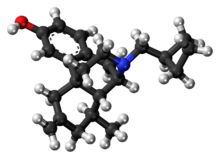Xorphanol
Xorphanol (INN) (developmental code name TR-5379 or TR-5379M), also known as xorphanol mesylate (USAN), is an opioid analgesic of the morphinan family that was never marketed.[1][2][3]
 | |
 | |
| Clinical data | |
|---|---|
| ATC code |
|
| Identifiers | |
| |
| CAS Number | |
| PubChem CID | |
| ChemSpider | |
| UNII | |
| Chemical and physical data | |
| Formula | C23H31NO |
| Molar mass | 337.507 g·mol−1 |
| 3D model (JSmol) | |
| |
| |
| | |
Xorphanol is a mixed agonist–antagonist of opioid receptors,[4][5][6] acting preferentially as a high-efficacy partial agonist/near-full agonist of the κ-opioid receptor (Ki = 0.4 nM; EC50 = 3.3 nM; Imax = 49%; IA = 0.84)[7][8][9] and to a lesser extent as a partial agonist of the μ-opioid receptor (Ki = 0.25 nM; IC50 = 3.4 nM; Imax = 29%) with lower relative intrinsic activity and marked antagonistic potential (including the ability to antagonize morphine-induced effects and induce opioid withdrawal in opioid-dependent individuals).[3][10] The drug has also been found to act as an agonist of the δ-opioid receptor (Ki = 1.0 nM; IC50 = 8 nM; Imax = 76%).[11]
Xorphanol produces potent analgesia, and was originally claimed to possess a minimal potential for dependence or abuse.[12][13][14] Moreover, side effects in animal studies were relatively mild, with only sedation and nausea being prominent, although it also produced convulsions at the highest dose tested.[15] However, human trials revealed additional side effects such as headaches and euphoria, and this was the subject of a lawsuit between the drug's inventors and the company to which they had licensed the marketing rights, which claimed that these side effects had not been revealed to them during the license negotiations.[16] As a result of this dispute, the drug was never marketed commercially.
See also
References
- Dr. Ian Morton; I.K. Morton; Judith M. Hall (31 October 1999). Concise Dictionary of Pharmacological Agents: Properties and Synonyms. Springer Science & Business Media. pp. 294–. ISBN 978-0-7514-0499-9.
- ANNUAL REPORTS IN MED CHEMISTRY V25 PPR. Academic Press. 10 October 1990. pp. 12–. ISBN 978-0-08-058369-3.
- Daniel Lednicer (25 June 1990). The Organic Chemistry of Drug Synthesis. Wiley. p. 61. ISBN 978-0-471-85548-4.
- Deborah L. Colbern; Willem Hendrik Gispen; New York Academy of Sciences (1 January 1988). Neural Mechanisms and Biological Significance of Grooming Behavior. New York Academy of Sciences. ISBN 978-0-89766-441-7.
- Gmerek, Debra E.; Cowan, A. (1988). "Role of Opioid Receptors in Bombesin-induced Grooming" (PDF). Annals of the New York Academy of Sciences. 525 (1 Neural Mechan): 291–300. doi:10.1111/j.1749-6632.1988.tb38614.x. ISSN 0077-8923.
- Cowan A, Zhu XZ, Mosberg HI, Porreca F (1986). "Central infusion of rats with agents selective for different types of opioid receptor". NIDA Res. Monogr. 67: 132–7. PMID 3018570.
- Gharagozlou, Parham; Hashemi, Ezzat; DeLorey, TimothyM; Clark, J David; Lameh, Jelveh (2006). "Pharmacological profiles of opioid ligands at Kappa opioid receptors". BMC Pharmacology. 6 (1): 3. doi:10.1186/1471-2210-6-3. ISSN 1471-2210. PMC 1403760. PMID 16433932.
- Bernard Testa (22 October 2013). Advances in Drug Research. Elsevier. pp. 245–. ISBN 978-1-4832-8798-0.
- Gharagozlou P, Demirci H, David Clark J, Lameh J (2003). "Activity of opioid ligands in cells expressing cloned mu opioid receptors". BMC Pharmacol. 3: 1. doi:10.1186/1471-2210-3-1. PMC 140036. PMID 12513698.
- Dr. S. S. Kadam (1 July 2007). PRINCIPLES OF MEDICINAL CHEMISTRY Vol. - II. Pragati Books Pvt. Ltd. pp. 214–. ISBN 978-81-85790-03-9.
- Gharagozlou, Parham; Demirci, Hasan; Clark, J; Lameh, Jelveh (2002). "Activation profiles of opioid ligands in HEK cells expressing δ opioid receptors". BMC Neuroscience. 3 (1): 19. doi:10.1186/1471-2202-3-19. ISSN 1471-2202. PMC 137588. PMID 12437765.
- Polazzi, JO; Kotick, MP; Howes, JF; Bousquet, AR (1981). "Analgesic narcotic antagonists. 9. 6-Methylene-8 beta-alkyl-N-(cycloalkylmethyl)-3-hydroxy- or -methoxymorphinans". Journal of Medicinal Chemistry. 24 (12): 1516–8. doi:10.1021/jm00144a029. PMID 6796691.
- McCarthy, PS; Howlett, GJ (1984). "Physical dependence induced by opiate partial agonists in the rat". Neuropeptides. 5 (1–3): 11–4. doi:10.1016/0143-4179(84)90014-3. PMID 6152317.
- Howes, JF; Villarreal, JE; Harris, LS; Essigmann, EM; Cowan, A (1985). "Xorphanol". Drug and Alcohol Dependence. 14 (3–4): 373–80. doi:10.1016/0376-8716(85)90068-7. PMID 4039650.
- Porter, MC; Hartnagel, RE; Clemens, GR; Kowalski, RL; Bare, JJ; Halliwell, WE; Kitchen, DN (1983). "Preclinical toxicity and teratogenicity studies with the narcotic antagonist analgesic drug TR5379M". Fundamental and Applied Toxicology. 3 (5): 478–82. doi:10.1016/S0272-0590(83)80023-2. PMID 6642105.
- Maruho Company Ltd v Miles Inc (1993) 13 F.3d 6